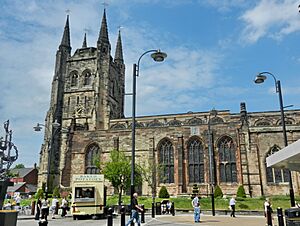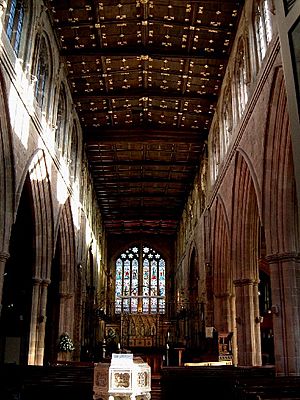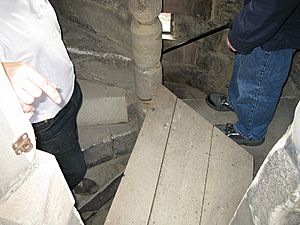Church of St Editha, Tamworth facts for kids
Quick facts for kids Church of St Editha |
|
|---|---|

St Editha's Church
|
|
| 52°38′03″N 1°41′39″W / 52.6342°N 1.6943°W | |
| Denomination | Church of England |
| Website | https://parishoftamworth.co.uk/ |
| History | |
| Dedication | Saint Editha |
| Administration | |
| Diocese | Diocese of Lichfield |
| Province | Canterbury |
The Church of St Editha is a very old and important church in Tamworth, England. It's a special building, listed as Grade I, which means it's one of the most important historic buildings in the country. People have worshipped here for over a thousand years! It is the largest parish church in Staffordshire.
Contents
History of the Church
The Church of St Editha stands on a spot where churches have been built since the 700s. The first church was destroyed by the Danes in 874. Later, Æthelflæd, a powerful Anglo-Saxon queen, helped build a second church.
However, the Danes ruined this church too in 943. Around 963, King Edgar helped build a new one. Saint Editha, who the church is named after, was probably King Edgar's aunt. She was known for her good and religious life. After she passed away in the 960s, she became the patron saint of this church.
Rebuilding After Fire
In 1345, a big fire destroyed both the town of Tamworth and the church. This led to the building of the fourth and current church. Work started in 1350 and finished in 1369. This amazing building is a tribute to Dean Baldwin de Witney, who led the rebuilding project.
For many years, St Editha's was a "collegiate church." This meant it had a group of priests called canons who lived and worked together. By the 1100s, the king chose who would be a canon here.
In 1548, during a time when many religious groups were changed in England, the college was closed. The church then became the main church for the people of Tamworth.
Famous Connections
Samuel Parkes, a brave soldier, was baptised here in 1815. He won the Victoria Cross, which is the highest award for bravery in the British military. He earned it during the Charge of the Light Brigade for saving a fellow soldier's life. His parents are buried in the churchyard.
The church was carefully repaired and updated in the 1850s and around 1871. Famous architects like Benjamin Ferrey, George Gilbert Scott, and William Butterfield worked on it.
The Double Spiral Staircase
One very special feature of St Editha's Church is its rare double spiral staircase in the tower. This means two separate staircases twist around each other in the same space, but they don't meet! There are only a few other examples of this type of staircase in the world, like at the Château de Chambord in France.
Beautiful Stained Glass
The church has some beautiful stained glass windows. Some very old pieces from the Middle Ages can be found in the vestry.
The large window at the east end of the main part of the church was made in 1870 by William Wailes. Other windows, made in 1873, were designed by Ford Madox Brown for a famous company called Morris & Co. The chapel's east window, from 1874, was designed by Edward Burne-Jones, also for Morris & Co. These windows tell stories and fill the church with colorful light.
The Church Organ
The Church of St Editha has a historic pipe organ that dates back to 1766. Over the years, different organ builders have worked on it, adding new parts and making improvements.
A new organ was built in 1927, but it used many of the pipes from the older instruments. The organ was fully restored between 2016 and 2017, so it sounds wonderful today.
A Famous Assistant Organist
In 1929, a 13-year-old boy named Ernest Titterton became the assistant organist here. He later became a very important scientist who helped develop the atomic bomb.
The church also has a Steinway Grand Piano, which is the only one of its kind in Tamworth.
See also
- Edith of Polesworth
- Dissolution of the Monasteries
- Grade I listed buildings in Staffordshire
- Grade I listed churches in Staffordshire
- Listed buildings in Tamworth, Staffordshire
Images for kids





